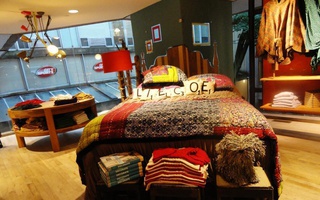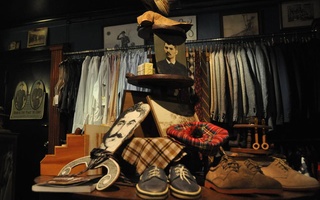But he doesn’t want the aesthetic to get in the way of comfort. It’s that comfort he found in English menswear shops—an aesthetic based on both style and function—which inspired him for this store. “I think it’s important, especially if you’re selling a used item, to make it comfortable to try it on, to look at it, make it easy by having everything organized,” he says. “People come in here, and…they don’t feel like they’re coming into a thrift store where it’s just racks and racks and racks of clothing; the whole place is very curated, you know?”
“Curated”—who would deny it?
TOP-DOWN ERGONOMICS
“Our inspiration comes from [our] home office, which is in Philadelphia,” says Katrine B. Hildebrandt-Hussey, a senior display coordinator at Anthropologie. A visual manager at Anthropologie is responsible for merchandising and overseeing displays. “My job is to conceptualize and execute those displays,” she says. Despite the “senior” in her title, Hildebrandt-Hussey has been at Anthropologie for less than three years. She received her Bachelor of Arts from Hartwick College and got a Masters in sculpting from Massachusetts College of Art and Design.
How do so many individual branches receive inspiration from a single office? We’re sitting on a leather couch in what appears to be a small living room on the top floor of the Harvard Square Anthropologie. Light streams through the glass wall and refracts in a sort of chandelier of glass spheres. The room is spacious, clean, and bright. It could easily appear sterile, but the faux living room feels intimate, homey, and definitely enviable—it’s a job well done.
As Hildebrandt-Hussey said, the basis of individual stores’ design comes from the home office in Philadelphia. The home office sends general concepts to its satellite stores, and it is then the job of the visual team to create in-store displays and designs based on that inspiration. The home office dictates that every room be based on a fictional person with a particular style and color preference. The visual team at each store then creates its own designs for that concept. Every Anthropologie store looks different for it, and if anyone has been inside an Anthropologie, he or she will agree the displays are stunning.
Often Hildebrandt-Hussey uses the merchandise as inspiration for the design of the store’s displays. “For instance, the dining table here has a lot of sea-related merchandise, and our display is going to be ocean-inspired,” she said. “So we’re using light fabrics that are sheer and wind-blown and rope.”
There’s little governance from the top, aside from the core concept given to individual stores. “It’s such an entrepreneurial company. [Home office] really want[s] each store to be unique and different, so there’s not too much that’s dictated,” Hildebrandt-Hussey says. It’s a relatively simple model that insures a reliability of aesthetic while allowing for the flexibility to appeal to smaller markets and preserve individual inspiration, all through a fascinating dissemination of inspiration. Even though there’s central guidance, Anthropologie leaves plenty of room for independent design choices in each of its stores.
Read more in Arts
Music "In Time of War"Recommended Articles
-
Tall, Skim, Decaf... Fiction?If you’ve ever been on an endless hunt for, say, a classic Elizabeth Bowen novel that hasn’t seen shelves since
-
Loeb Fellow Urges Activism in DesignThere is a growing movement in architecture toward social activism, according to design activist and current Loeb Fellow Bryan Bell.
-
TED Curator Speaks at GSD Class DaySpeaking in front of a packed audience in Piper Auditorium at the Harvard Graduate School of Design’s Class Day, Technology Entertainment and Design (TED) Curator Chris Anderson encouraged the graduating class to pursue knowledge and to never stop learning.
-
 Free People Company Spreads Bohemian Vibe
Free People Company Spreads Bohemian Vibe -
 Oona's Experienced Clothing To Launch Online Store
Oona's Experienced Clothing To Launch Online Store -
Student Art Competition Launched for Radcliffe Yard GardenThe Radcliffe Institute for Advanced Study has launched an annual University-wide art competition allowing students to solicit proposals and designs for an installation to be displayed in the garden bordering Brattle Street in the Radcliffe Yard.













